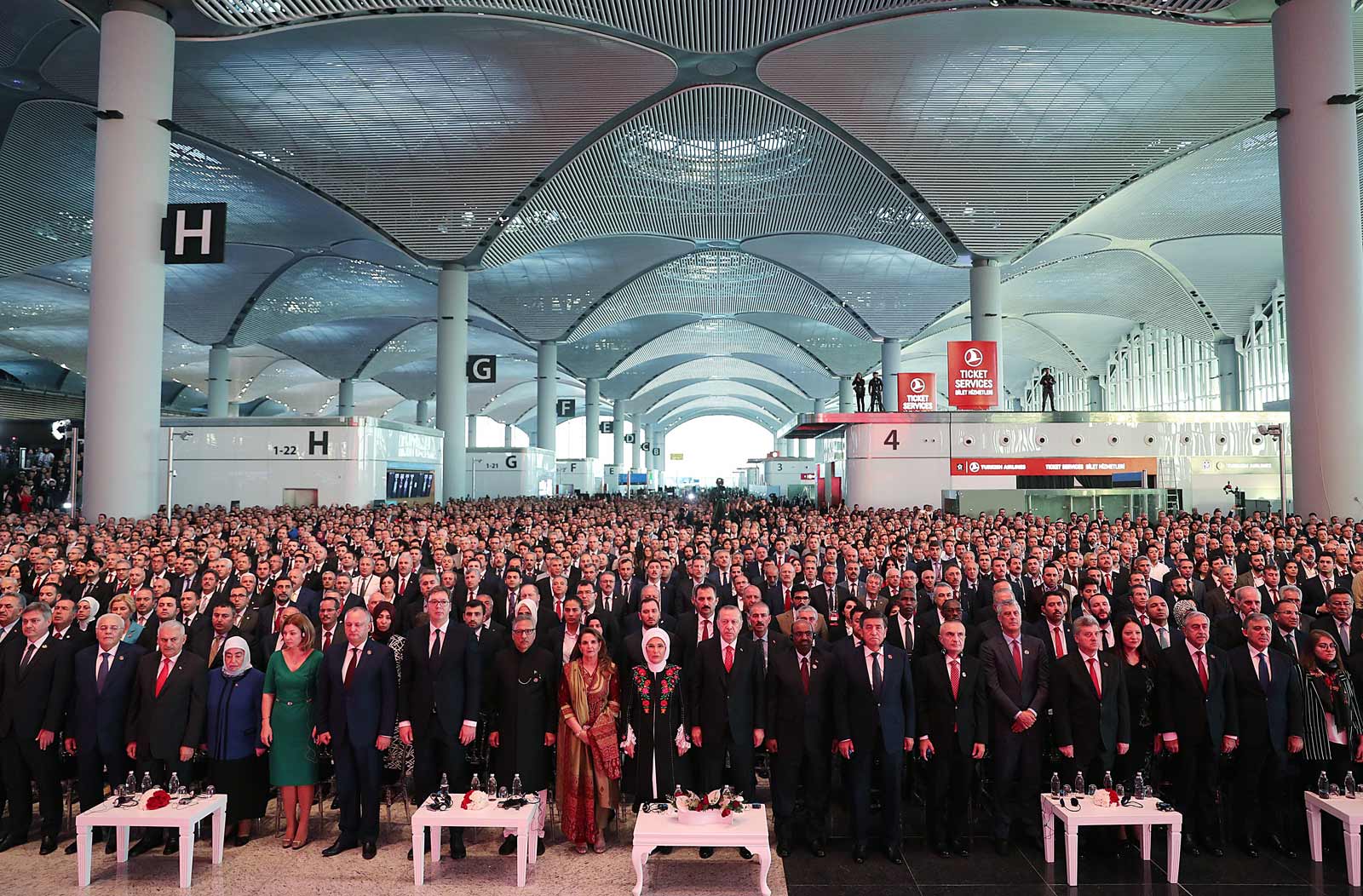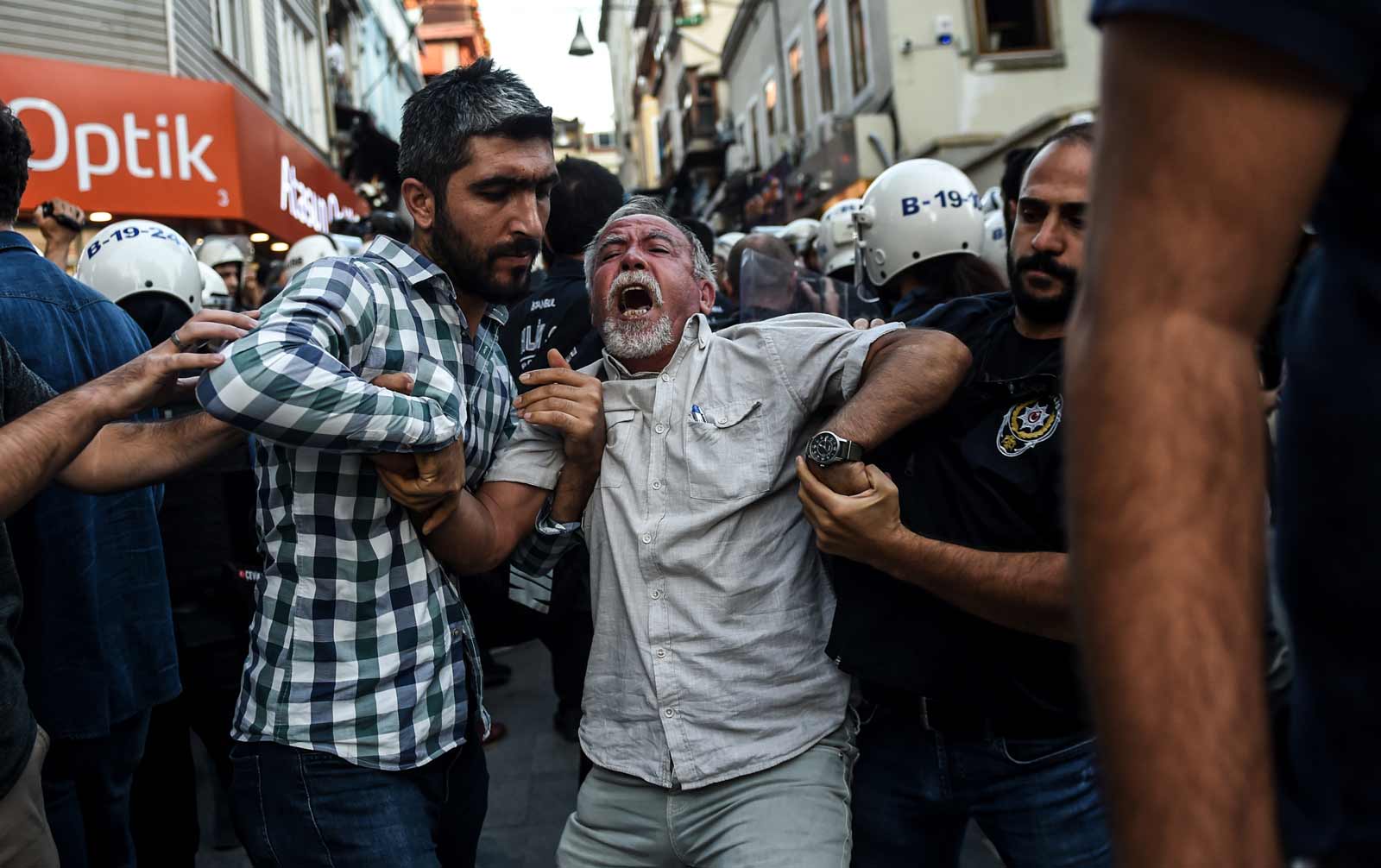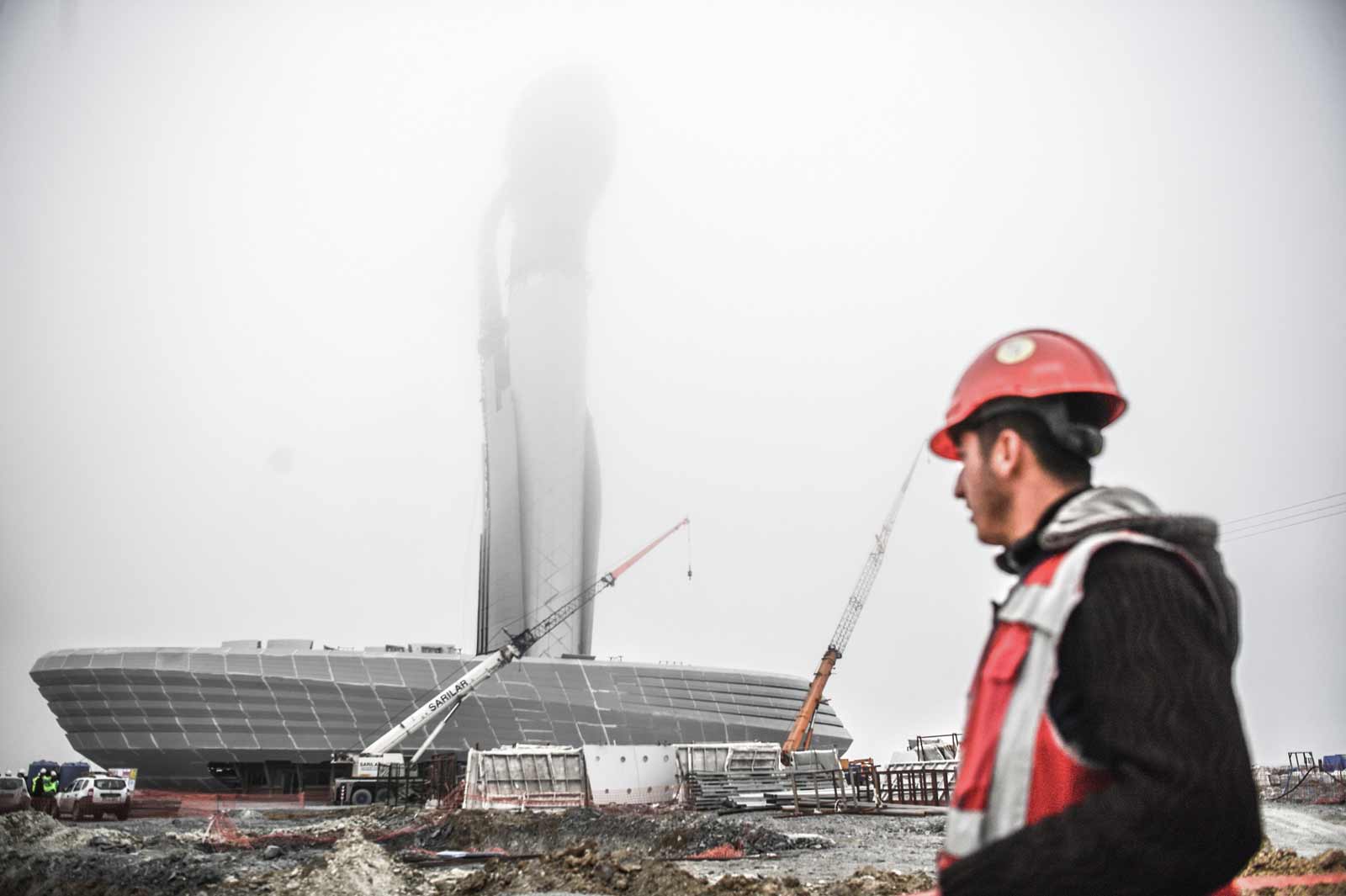This week, planes began landing at Istanbul’s new airport. At least the guessing game over its name is complete—as President Recep Tayyip Erdoğan declared “Istanbul Airport” open—since this is more than can be said for the airport itself: the additional terminal buildings and runways will not be finished until 2028. Then, finally, the airport’s planned capacity of 200 million passengers per year and its size (7,594 hectares) will make it the world’s largest airport, just as Recep Tayyip Erdoğan desired. It will be far ahead of Hartsfield-Jackson Atlanta (103 million passengers, 1,902 hectares), Beijing Capital (95 million passengers, 1,480 hectares), Dubai (88 million passengers, 2,900 hectares), and Tokyo Haneda (85 million passengers, 1,214 hectares). A report from Turkey’s Directorate General of Civil Aviation borrows from literature to ennoble the visionary nature of Erdoğan’s signature project: “Terminal buildings resemble vertical towns similar to those imaginary towns which Italo Calvino describes in his unforgettable work Invisible Cities.” Istanbul’s new airport is thus to embody its own Invisible City.
Even as, in recent weeks, the international community and foreign media have been obsessing over the fallout from the Jamal Khashoggi case, Turks are more preoccupied with domestic affairs and, in particular, their president’s grand plans for transforming Turkey into a regional economic powerhouse. The titanic scale of the new airport project that promises to deliver that vision has come, however, at a steep price, $12 billion, and at a time of severe economic crisis. Since January 2018, the Turkish currency has lost nearly 35 percent of its value against the dollar. Many consider the airport and Erdoğan’s two other huge infrastructure projects, a new intercontinental bridge in Istanbul and a canal connecting the Black Sea to the Sea of Marmara, as irrational endeavors; and it is doubtful that most Turks can afford air travel when the average price of a ticket has risen 106 percent over the past year. But Erdoğan defiantly calls the programs his “crazy projects” and says they will help raise Turkey’s GDP to $2 trillion by 2023, and lift Turkey out of its financial crisis.
*
Erdoğan’s recent sharp turns in economic policy have baffled observers. He advocates lowering interest rates as an antidote to inflation, while economists say he misunderstands how interest rates work. He pushes for unassailable control over monetary policy, which analysts say undermines the independence of Turkey’s Central Bank. This summer, as Turkey’s currency value fell dramatically during a dispute with President Trump over an American pastor imprisoned in Turkey, Erdoğan commissioned a new, lakeside presidential summer palace.
Erdoğan started out as an economic pragmatist back in 2002, when his Justice and Development Party (AKP) rose to power, but his response to the financial crisis of 2008 and the recession was to launch a new policy of authoritarian Keynesianism. In 2011, shifting the focus of the Turkish economy to construction projects, he proposed building the canal between the Black Sea and the Sea of Marmara: project “Canal Istanbul.” On completion in 2023, this waterway—some 500 feet wide, more than 80 feet deep, and thirty miles long—would surpass the Panama and Suez canals in scale, effectively turn Istanbul’s historic center into an island, and reduce oil-tanker traffic through the narrow Bosphorus strait. This transformation would, Erdoğan said, allow the Bosphorus to become “the place it was in the old days, a natural wonder.”
In the sixteenth century, the Ottoman Sultan Süleyman, known as “the Lawgiver” by Turks and “the Magnificent” by Europeans, dreamed of something similar. Süleyman’s canal would have allowed ships to carry timber for the Ottoman Navy to expand its Mediterranean fleet and wood to the inhabitants of Constantinople to heat their homes. But the huge technical challenges prevented the realization of this Ottoman dream. Four centuries later, Bülent Ecevit, a left-wing politician known by his supporters as “the Dark Boy” because of his hair color, made a similar proposal. During his campaign for the 1994 local elections, he promoted the canal scheme as his “Mega Project,” but 87 percent of Turkish voters didn’t buy it.
In the 2011 general elections, however, two months after the announcement of Canal Istanbul, Erdoğan’s AKP received 49 percent of the vote—making it the largest party in parliament and giving Erdoğan himself an unassailable mandate. Erdoğan, hailed as “the Chief” by his followers who applauded his “crazy projects,” soon announced another of them: Istanbul would have the world’s largest airport. A year later, in May 2012, Turkey’s Ministry of Transportation gave its approval for a third bridge in Istanbul. Located a few miles east of the area allocated for the new airport, the new bridge would be the world’s second-tallest and one of the widest. With a budget of $2.5 billion dollars, it would connect the new airport and the canal project to the city, and it would take the name of another Ottoman sultan, Selim I “the Grim,” the first to assume the title “Caliph.” The construction of the bridge began on May 29, 2013, the anniversary of the Ottoman conquest of Constantinople in 1453.
Advertisement
*
From the outset, these big infrastructure programs have been interesting for their interaction with democracy: at their best, as with Franklin D. Roosevelt’s New Deal and Dwight D. Eisenhower’s Interstate program, such projects can be Keynesian expressions of national will. But under an undemocratic form of Keynesianism, as in Erdoğan’s Turkey, they instead became symbols of a slide into illiberalism. Young Turks were the first to notice: the week construction on the bridge began in May 2013, about a hundred Turkish environmentalists, most in their early twenties, occupied Gezi, a public park in central Istanbul. They pitched tents and sprayed environmentalist graffiti on walls against the “crazy projects.”
Gezi was inspired by the Occupy Wall Street movement of 2011. With the help of social media, protests expanded to dozens of Turkish cities and the number of protesters increased to around two million in a fortnight. Der Spiegel put Gezi protesters on its cover; the headline was Beugt euch nicht (“Don’t Bow”). A Turkish columnist responded by asking, “Why should I take the side of Germany and Lufthansa and say no to the new Istanbul airport?” Many conservatives considered the uprising as a foreign-backed attempt to hinder new development.
At the same time, in July 2013, the group of Turkish environmentalists at Gezi Park formed the Northern Forests Defense (NFD). In the half-decade since its formation, NFD has issued hundreds of statements about the airport’s potential environmental effects. On its website, NFD published an English language e-book titled The Third Airport Project whose findings make for sad reading. They documented that, according to the government’s own figures, some 650,000 trees would be cut down and more than 1.8 million would be moved during construction. The group also pointed out that the project endangered some 600,000 birds, which pass close to the airport on their spring and fall migrations. Aside from the disruption to the birds’ habitat and migration routes, the airport’s location makes the birds a significant strike-hazard for airliners.
On November 12, 2013, at the New School in New York, the Turkish artist Burak Arıkan presented a collective data-mapping project that he called Networks of Dispossession. The three-dimensional chart documented the complex relationships among the Turkish government’s many projects and the companies involved in realizing them. It linked more than 600 companies, fifty government institutions, and forty media organizations with 500 projects, including two bridges, three convention centers, nine dams, twenty-two harbors, six highways, ten hospitals, twenty-five hotels, three nuclear power plants, three oil refineries, three religious buildings, sixty shopping malls, and the new Istanbul Airport.
Networks of Dispossession was exhibited at the Istanbul Biennial in 2013, and an updated version displayed on a large wall at the MAXXI museum in Rome from 2015 to 2016. In both versions, the new Istanbul airport appears at the heart of a profit-generating confluence of public projects and private companies: it is the centerpiece of what Erdoğan calls the “New Turkey.”
The airport project in particular revealed overly close ties between the government and the lenders and builders. The airport’s local contractor, a consortium of five builders, won the contract in 2013. To deliver on its bid, it took a loan from six Turkish banks. Bloomberg reported that one bank loaned $1.5 billion to the contractors, while two others chipped in $966 million each. Over the next half-decade, the money dried up; the project’s budget has ballooned, and gone way over. In April 2018, the consortium asked for an additional $1.23 billion to finish work on the airport.
There have also been growing complaints about conditions for workers on the job. In October 2016, Evrensel, a Communist Turkish newspaper, reported that workers were living inside crowded shipping containers and laboring up to sixteen hours a day. A “security coordinator” interviewed by the paper likened the construction site to a prison. Workers have received little instruction about safety, the paper claimed, and there have been numerous fatal accidents; workers have been crushed to death by equipment at the site or have fallen to their deaths. There have been conflicts among the men as well. One death occurred when a thirty-six-year-old man had a fight with a fellow laborer inside a container and was set on fire.
Advertisement
Rumors about the number of deaths soon spiraled out of control. In the Turkish Parliament, an opposition lawmaker filed a formal inquiry about reports that up to 400 workers had died at the construction site. In February 2018, the government announced that twenty-seven, not 400, workers had died over the past three years. The last reported death occurred in July, when the cable of a mobile crane broke, dropping material weighing thirty tons on the crane’s cabin where a fifty-two-year-old operator sat.
Over the past year, the government initiated a media campaign to allay public concern about the airport. The state-run news agency Anadolu published a video filmed at the construction site that featured laborers enjoying a game of snooker, playing musical instruments and dancing, buying coffee at a well-supplied market. But when 537 laborers protesting working conditions inside the airport were detained by police in September 2018, the news agency didn’t report the story. Subsequently, an Istanbul court ordered twenty-four construction workers and union leaders detained during the raid to be held until their trial, a measure Amnesty International called “a blatant attempt by the authorities to silence legitimate protest.” According to Human Rights Watch, at least thirty-eight workers have died in “preventable work-related accidents” at the airport site, “and many more have been badly injured.”
*
On June 21, three days before this year’s presidential election, Erdoğan’s official plane landed on the airport’s first runway. Earlier, newspapers had run reports of laborers rushing to wrap up the construction in time for the president’s sixty-fourth birthday on February 26, but that deadline was missed. The opening of the subway line connecting the airport to central Istanbul, scheduled for 2018, was also delayed, to 2019.
Istanbul’s first airport, which opened in 1912 as an airfield and in 1953 as an airport, was named after Atatürk, the founder of modern Turkey. The second, which opened during a year of debilitating financial crisis in 2001, was named after Turkey’s first female pilot, Sabiha Gökçen, who was Atatürk’s adopted daughter. There is also an airfield, located in a town called Çatalca on the outskirts of Istanbul, named Hezârfen Ahmed Çelebi, an Ottoman inventor from the seventeenth century.
In his travelogue, Seyahatname, Ottoman writer Evliya Çelebi claims Hezârfen had flown over the Bosphorus with artificial wings in 1638. Hezârfen, Evliya says, first “practiced by flying over the pulpit of Okmeydanı eight or nine times with eagle wings, using the force of the wind.” Then, as Ottoman Sultan Murad watched from his mansion, Hezârfen “flew from the very top of the Galata Tower and landed in the Doğancılar Square in Üsküdar, with the help of the south-west wind.” His flight made the sultan both proud and afraid: after giving him a sack of golden coins, Evliya claims, the sultan called Hezârfen a scary man “capable of doing anything he wishes,” and exiled the inventor to Algeria.
Evliya, who was born forty-five years after the death of Süleyman “the Magnificent,” had a fanciful approach to his writing; in Seyahatname, his imagination certainly supplied more than he could have remembered. Still, the image of an Istanbul local flying over the Bosphorus with artificial wings, continues to haunt the Turkish imagination. Some columnists demanded that the new airport be named Hezârfen; others preferred the name of his chronicler and asked for an “International Evliya Çelebi Airport.” Most pushed for Atatürk, since the current Atatürk Airport will be closed to commercial aviation at the end of 2018. Conservative Turks started an online petition to have it named “Abdul Hamid II Airport.” This way, they wrote, “Muslims who land in Istanbul can experience the joy of arriving at the center of the caliphate.”
On a lazy Sunday last month, I attended a family luncheon in Poyrazköy, a northern Istanbul town a few miles from the new airport. On our way to the restaurant, the family sedan climbed through steep hills thick with the pine trees of the Northern Forests. The windows were down, the air was refreshing and unpolluted. As night fell, a breeze came from the Black Sea and the red lights of the Yavuz Sultan Selim Bridge, which stood in the background, glowed. My cousin’s three-year-old son ran to the beach, where he played with his uncles and screamed with joy. Someone had lit a fire nearby. Youngsters savored the view of the sea by its light.
I relished the moment, but knew the serenity would soon fade. On December 30, a convoy of thousands of trucks will rattle the Yavuz Sultan Selim Bridge as they transport the equipment of Turkey’s national carrier from Atatürk Airport to the unfinished new airport building. The chief executive of Turkish Airlines has compared the operation to the Ottomans’ carrying their ships over land during their conquest of Constantinople in 1453. It is as if the natural landscape of the Northern Forests were enemy territory that has finally been captured.
In The Red-Haired Woman, the 2016 novel by Turkey’s Nobel laureate Orhan Pamuk, a middle-aged Turk who makes a fortune as a property developer looks down at Istanbul from his airplane seat. Wracked with guilt over an incident in his youth that involved a man’s death, the businessman imagines seeing the other’s preserved body at the exact place where he thinks the man drew his last breath; but the developer’s guilt also involves what he has done to the city of Istanbul. While international observers have been preoccupied with a man’s death, that of Jamal Khashoggi, and the mystery surrounding the whereabouts of his body, many Turks may in coming days feel more acutely that other burden of guilt the developer carries.
The new Istanbul Airport may have added 225,000 jobs to the economy and increased the GDP by an estimated 5 percent by 2025, and replaced a decaying and inadequate city airport, but this drive for growth and profit has come at the cost of something irreplaceable. As Turkish planes prepare to land on the runways of the world’s largest airport of the future, we may look at the Invisible City, its lights glittering at night, and remember that its dark spaces once abounded with towering trees and wandering birds, with families of foxes and flocks of sheep, with crystalline lakes and endless green fields—with life.




